~ THE TURNING OF THE WHEEL ~
Summer Solstice 2011
~ STILL AVAILABLE ~
Leather Bound Limited Edition of Issues #5–8 + CD!
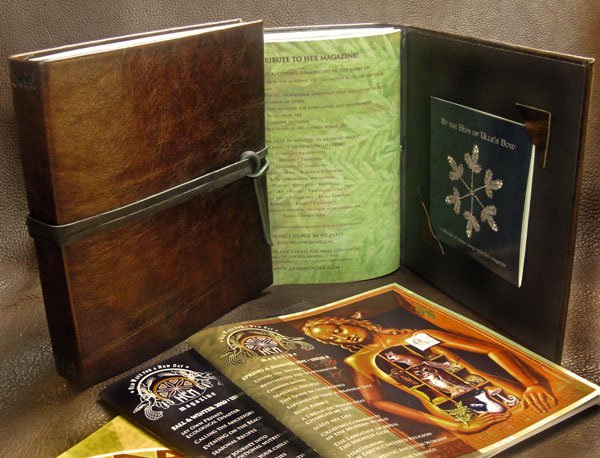
An edition of 13, and signed by the artisan (Jason Hovatter) and editors of Hex. One copy is very, very special (see photograph below).
12 of the leather bound copies are $100 + shipping each; the special edition copy is $150 + shipping. If you want to order send me an email: arrowyn@hexmagazine.com. It’s first come…first serve!
Note: Issue #5 is sold out…this is a small reprint run.
All proceeds go to Hex Press to support its continued effort to provide folks with an excellent volunteer-based, community-supported, not-for-profit publication.

* * * * * *
And don’t forget: the much anticipated Hex Folk Market (www.hexfolkmarket.com) is here! Join our online market community in celebration of folk ways and sustainable living. Browse through our selection of international merchants or set up your own shop for free!
* * * * * *
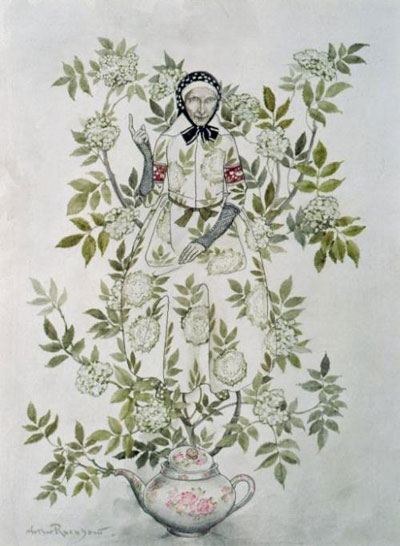
The Elder-Tree Mother by Arthur Rackham, 1867-1939
The Elder-Mother: A Tree to Remember this Midsummer
The wheel of time on Midgard/Earth has turned yet again to Midsummer. Sol is closer to us than ever and sending out plenty of her nourishing energy. This is a time when crops should be flourishing and food plentiful. Elder Heathens knew this as a time for one of three major sacrifices. In Heimskringla: History of the Kings of Norway, Chapter 8 tells us:
“A sacrifice was to be made for a good season at the beginning of winter, and one in midwinter for good crops, and a third one in summer, for victory.”
Some of these traditions actually come to us from a plant/wort called elder…and this elder or elderberry is probably blooming now in a hedge or ditch near you. Indeed, the blooming of elderberry in England heralded the arrival of the summer months (while it’s ripe berries signaled the summers end).
Traditionally most Heathen households probably had an elder bush growing close to their home, where it might have been thought of as a living being known to some as the Elder Mother.
“Some call me Elder Mother, others a dryad, but my real name is Memory. It is I who sit in the tree as it grows and grows, and I can think of the past and relate many things.”
~ Hans Christian Andersen, The Elder-Tree Mother 1
Germanic peoples may have associated the elder, which Germans call holunder, with Frau Holla/Holda, who could be thought of as the queen of dwarves and elves. It was also believed that house spirits lived in an elder that grew near the house. Sacrifices were made to the house elderberry by Germanic, Scandinavian, Celtic, and Slavic peoples with foods such as milk and beer poured out under the wort for the house spirits.
Swedish folklore tells that if you spent the night under an elder on Midsummer Eve you could see the Elf King and his court go by. Some have found an association with Holda and Hela and see Holda’s home as a boundary between Midgard and Hel, which would mean the elderberry bush was a doorway of sorts. Later during Christian times the elder was thought to help protect folk from the devil!
The cutting of an elder was forbidden unless permission was first granted, which further suggests that something of note lived in or under the elder bush:
“Lady Ellhorn, give me some of thy wood and I will give thee some of mine when it grows in the forest.”2
The Elder has found it’s way into many bits of folklore and fairytales. This is true even of emerging contemporary folklore. For example in the Harry Potter stories the most powerful wand in the Wizarding World is the Elder Wand, which is made of sambucus or elder wood.
One bit of old ‘lore’ I found interesting while reading about this wort was the similar name Eldir found in “Lokasenna” #1-5. In this story Loki plans to burst into a feast at Ægir’s hall. As he reaches the door of the hall he meets Eldir, who is one of two of Ægir’s servants. They have a discussion, after which Eldir plays no further part in the story. Apparently his job is to stand outside the door, just like an elderberry might have.
In another bit of lore from Lee M. Hollander’s translation of “Havamal” #137 we learn that “’gainst house-strife, the elder” and Hollander notes that “In folklore, the elder-bush exercises a pacifying influence.” We might wonder whether Loki’s barbed words would have been sharper still if not for Eldir’s potentially placating influence.
The elder is a species of the Sambucus genus, which contains a few dozen species ranging in size from small bushes to small trees. With the onset of the colder months some elder only shed their leaves, while other species die back in the winter and re-sprout from their roots in the spring. These latter are called Dwarf Elders. In Europe Sambucus nigrais is one of the dominant species, while in the USA Sambucus canadensisis is more commonly found. Nearly all of these species are interchangeable when used for medicinal purposes, though careful investigation should proceed any usage since this wort has some potentially deadly properties and some deadly look-alikes.
Historically all parts of the elder seemed to have some usage across the old world lands. Elder has been, and still is, used to make wine, beer, liquors, syrups, medications, poultices, washes, and more, and as a flavoring additive for all of these as well. Many commercial products can still be purchased with elder as an ingredient, and it’s often found in cold preparations. It’s high in Vitamin C and very helpful in fighting cold, flu, and viruses. Some studies say it is useful for treatment of the H1N1 flu virus! Apparently some of it’s properties can breach the cell of the virus and allow the immune system to attack the invaders.
The elder flowers and berries are the safest and the parts we use most often today. However even these parts can cause vomiting and diarrhea. To help deactivate or diminish their undesireable properties the flowers or berries are usually heated/cooked in some way. As always it’s better to be safe than sorry when using hedge-ways. Dried Elder flowers and berries are available commercially for the beginner.
Today elder flowers can be made into teas, fried treats or medicinals; the berries can also be used like raisins, though they aren’t sweet. Both the flowers and berries can be carefully dried without washing, and this form seems to work better at extracting or enhancing flavor. Should you choose to go further try making some of the cordials and wines so you can sing along with Elton John’s “Elderberry Wine.”
The elder is a wort that could be explored almost endlessly. For instance elder is the thirteenth tree of the Ogham. Try exploring for yourself some of the tales associated with elder; I urge further study of this history-laden wort, especially for those drawn to the hedge. Do consider planting some near your home and just maybe you’ll find it a marker for the doorway to your ancestors!
Hail Day!
~ Teresa L. Hedgewife
Midsummer 2011
Further reading:
1 http://www.gutenberg.org/files/32571/32571-h/32571-h.htm#Page_174
2 http://www.botanical.com/botanical/mgmh/e/elder-04.html
http://en.wikipedia.org/wiki/Sambucus
http://elderberrylife.com/elderberrylore.html
http://en.wikipedia.org/wiki/Elder_Mother
* * * * * *
~ Call for Submissions ~
Hex Magazine is always seeking fresh contributions! We’re keen both to nurture new talent and to honor established thinkers! Join us –
Submissions for Issue 10 (Spring 2011) due Autumn Equinox 2011.
Submission guidelines are available at
http://hexmagazine.com/submit/guidelines/
Feeling Hexy?
Hex is putting out an initial call for Heathen Erotica.
For a side project, not a regular issue.
It will be published when we get enough material.
Accepting submissions for stories, poetry, art, photography, recipes, whatever. You can submit under your own name or a nom de plume.
The usual high standards of quality apply! IE: if it’s smut, it better be really good smut!
Send submissions to submissions@hexmagazine.com
* * * * * *

•FEHU•
Old English Rune Poem
Feoh (Money) is a comfort to humans all;
but each one should deal it out abundantly,
if he wants before the Lord to chance judgement.
Old Old Icelandic Rune Poem
Fe (Money) is kinsman’s quarrel
and flood-tide’s token
and necromancy’s road.
Old Old Norwegian Rune Poem
Fe (Money) causes kinsmen’s quarrel;
the wolf is reared in the forest.
~ Rune poem translations by Sweyn Plowright,
http://www.mackaos.com.au/Rune-Net/Primer/
Money is bound inextricably with fear. It triggers our deepest survival circuitry, our terror in the face of the unknown. The threat of loss can reach to the farthest bounds of our imagination if we allow it. Necromancy’s road? The road we fear leads into the halls of the dead.
Let us, then, follow Money’s dark thoroughfare. Whither does it draw us? It draws us to Jarnviðr, the Iron Wood of Norse mythology, itself a highway between earth and the afterlife. This forest is also the ancestral home of wolves: “the wolf is reared in the forest.” Bleak stuff, this. Money, it seems, dives straight into our most submerged fears.
Money-fear, which is survival fear, can all too often be a paralytic reaction. Rabbit in headlights, we are lost in a miasma of frightened thoughts. It is easy to feel that we are destined to fail, to be consumed and dissolved. Money is fickle, harsh, and arbitrary; our thin skin is laid open and stained red by its callous kiss.
Survival fear is a profound atavism, a resurgence of deep biological memory. Fear of death, fear of pain, must surely be one of the oldest instincts active in human life. This fear, beneath our sophisticated elaborations, is simple and direct. It has kept myriad beings alive for millions of years. Fehu quietly conceals an unstoppable torrent of ancestral emotion.
If fear has proven such a boon to life, its preserver and encourager, why does it cause us to freeze? Because it can partner with the feeling of powerlessness. Thus we feel we do not have enough within ourselves to ride out the necromancer’s road or survive the eerie haunts of Jarnviðr. Thus we are parched for faith, when no clear way towards the land of the living offers itself.
So Fehu points us right into dreary valleys and choked-off passageways. The complexity of the customs and culture that wind around money is a thin veneer over ancient terrors. No wonder that in the face of poverty we fear and feel shame, embarrassment, and humiliation: money trouble is almost an intimation that we are not worthy of survival.
Lest we become mired in bleakness: recall that the purpose of “necromancy” is to serve life and the living. Recall that the Jarnviðr, though it leads to the afterlife, can thereby also be used to find passage to the sky, to the new vistas visible from elevated climes.
It hurts to face the fact of one’s fear, yet fear is also a great teacher. It might be that our fears are pointing us to important information: to things we need, principles that strengthen us, relationships we value. In the face of survival fear we feel an urge to tighten up, clamp down, and freeze, but what if instead we opened ourselves, looked for new possibilities in lateral directions?
This is certainly one implication offered in the recommendation that “each one should deal [money] out abundantly.” The time to reinvest in ourselves comes when we feel the greatest lack. We interpret survival fear as the message that we are powerless to effect change; but the dark road on which we find ourselves is for walking, and it has an end if we keep one foot in front of the other.
The greatest poverty that anyone can suffer is poverty of the imagination. If we cannot imagine change, new hopes, encourage ourselves through our vision of the future, then overwhelm can easily follow. Even permitting ourselves modest dreams can be deeply nourishing. We owe it to ourselves to carefully husband them.
The underworld is a place of imagination and dreams, and the road that Fehu drags us down leads back to our own inner resources. Fehu tells us that our greatest wealth lies within us, within our curiosity, creativity, and persistence. This source of “comfort to humans all” is carried within the heart and mind and limb.
Fehu invites us to face fears and shed illusions, precisely so that we can harness our imagination as a road to new action. The threat of hardship in these difficult times is ever-present; yet ultimately this is a wonderful opportunity to discover our inner riches and bring them to manifestation in the world around us.
* * * * * *
~ HEX ISSUE 8: Spring and Summer 2011 ~
Support Hex! We are community-supported not-for-profit publication. You can support us by heading to http://hexmagazine.com/subscribe/ and ordering magazines, CDs, and prints, and by spreading the word to all like-minded folk!
* * * * * *
By the Hum of Ullr’s Bow: Winter Songs Compilation CD
is still available!
Bands on the compilation CD include:
• A Minority of One • Allerseelen • Andrew King • At the Head of the Woods
• Beastianity • Hamramr • Irij • Ironwood • Ruhr Hunter
• Sangre Cavallum • Sieben • Steve von Till
• Svarrogh • Waldteufel • Wardruna
(You can read more about the artists here:
http://hexmagazine.com/harvest/winter-songs-cd/).
* * * * * *
: Issue Three Almost Gone! :
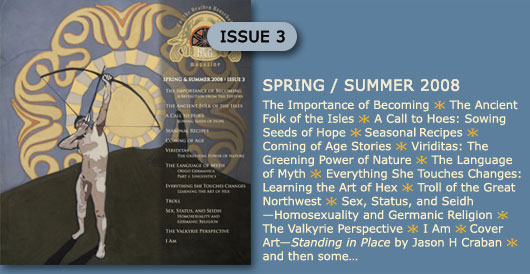
Issues One, Two, Four, & Five are sold out!
Limited numbers of Hex Issue Three (and also issues Six, Seven, and Eight of course) remain…
Order at:
* * * * * *
Until Loaf Fest, may you and your
household be blessed and kept. Hail!
~ HEX Magazine
* * * * * *
We are currently looking for:
• submissions
• funding
If you are interested in applying or have any suggestions,
contact: info@hexmagazine.com
* * * * * *
Due date for Spring 2012 submissions
is Autumn Equinox 2011
Support your community while exposing like-minded
folk to your goods and services…
Advertisements must be relevant to HEX readers, and inclined toward a Heathen aesthetic. Prices listedare for completed AD files. If you need additional graphic design, we can help. Just contact us about our design fee.
AD space is now available in the newsletter for $10 a run.
Contact info@hexmagazine.com if you are interested.
>I< HEX >I<
> Please forward to all interested and relevant parties <



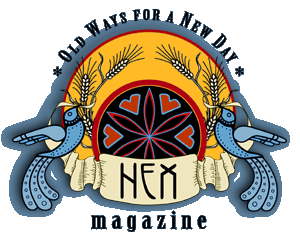

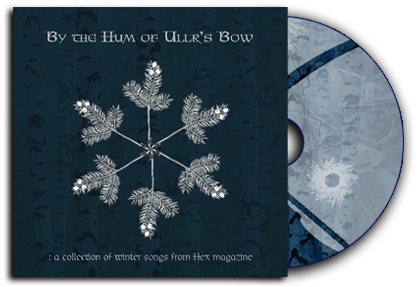






Leave a Reply